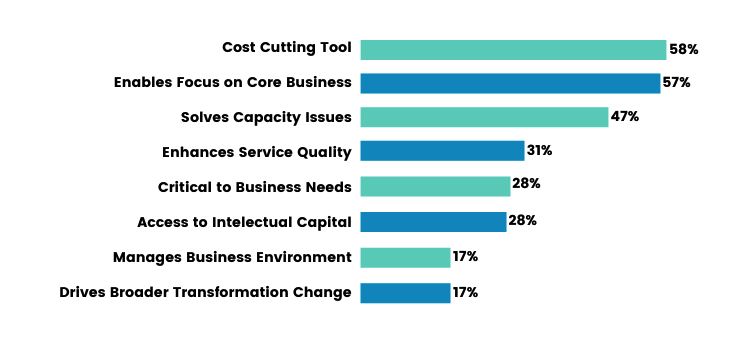If you’ve never outsourced software development before, it might seem a little intimidating to start outsourcing. That’s perfectly understandable! Putting your trust in external IT company to deliver you IT project is a big decision in any capacity, especially when the success of your business as a whole can depend on it.
78% of businesses have a positive view of outsourcing. This is key, not only to your own confidence in the idea but also that of your stakeholders, who will be pleased to see that the software part of the journey is being taken care of by the right company.
The reality is that although there are several benefits to outsourcing, there are also certain needs to ensure that it is smooth. This article will help you outline the most important pros and cons of it outsourcing that will help you make the right decision for your business. Let’s get started!
Pros and cons of IT outsourcing
Company successfully outsourced are certainly well aware of the advantages of outsourcing, but it is also worth remembering its disadvantages because it is not a solution for everyone. First, outsourcing may help non-digital businesses cut project development expenses. Second, it provides a chance to recruit highly skilled individuals talents for a specific project. However, IT outsourcing has several disadvantages. In our post titled Software Development Outsourcing Models, we discussed the many forms of IT outsourcing, and now we'll highlight the main pros and cons of it.
Pros of outsourcing
Why do companies outsource software development? Here are some of the key benefits of outsourcing your business's software development. Outsourcing is based on working with outsourcing providers whose job is to provide tech talents to support your project.

Reduce software development costs
This is one of the most important competitive advantage. The rapid pace at which technology evolves means that the software development industry is ever-changing. Hiring and training software developers for a project can turn into unnecessary overhead costs.
High-quality software development team
With software outsourcing services you are able to hire a diverse software development team with all sorts of skill sets. Those niche experts can help you to understand the market from a domain and technical perspective.
Save time on hiring specialists
The saying ‘time is money really is true, so you can cut costs ever further by bringing in pre-approved specialists. With developers in outsourced teams, the hiring and researching work has already been done. Now, you can swoop in there and enjoy all the successes by spending a minimal amount of time. The whole process of hiring an outsourced team can be equal to or less than the time it takes to hire one single developer into your in-house setup. Think about the time, and therefore money, that this has the potential to save you.
Gain access to world-class talent
Part of the beauty of an outsourcing network is that you can bring in some of the finest software development from the other side of the world at the click of your fingers (kind of) on an outsourced basis. As long as you can utilize the project same management direction and collaboration tools, you can reap all of these amazing outsourcing benefits.
Flexible team capacity and scalability
An awesome thing about software development outsourcing is that it can give you a sense of ‘on-demand’ service. Imagine a scale between skills and cost (sure, it’s a loose idea), but this will help to visualize the freedom that you have with this opportunity. Scaling your project as and when you need it has huge benefits for time and money.
Work with a managed team
It’s not just individual developers that can save you manpower, and therefore time and money. Management is a huge part of this too. Hiring the right manager for an in-house team can be one of the most difficult things you will do with your company, but you don’t have to worry about that as much when outsourcing, as every team will already be managed. You’ll certainly need management to guide the project down the line, but a lot of the weight of management can be taken away from your own company.
Focus on your core business
And that brings us nicely to the final benefit of working with an outsourced software development company. Being able to focus on your core business will undoubtedly allow you to get a better result overall, as there will be nothing to distract you and lose sight of your original idea. This could well be the most important thing to focus on overall. More important, the use of outsourced workers buffers regular employees from demand swings and enables the organization to form stronger bonds with its regular personnel than would be feasible otherwise.
Cons of outsourcing
Lack of control over the process and management
As a business leader, it may feel uncomfortable and alien to be handing over vast swathes of the infrastructure management and processes of your organization to another outsourcing company and indeed this perceived loss of control can be disconcerting. Critics of IT outsourcing argue that no external supplier can match an in-house team's responsiveness and service levels, partly because the vendor is not subject to the same managerial direction and control as your workforce. Of course, the lack of control itself is not a risk, but rather what may arise as a result.
Solutions
- Transparency will be required between your organization and outsourcing firms regarding which elements of the management structure you will require to retain control of. A “RACI” document showing responsible/accountable/consulted/informed can help here.
- Focus on outcomes and metrics whether this be throughput, customer experience or something else. Allowing the outsourcer to focus on results can provide some leeway in terms of how those results are achieved.
- Determine a communication cadence. Often regular reports can be a good way for the outsourcer to provide periodic updates to the client.

Communication and culture issues
A recent study showed that nearly 90% of businesses believed communication to be one of the key challenges with outsourcing capabilities. This can arise from a number of factors such as culture (both national and organizational), language, and the distributed nature of teams.
This can be further compounded by the client/service provider dynamic, where service vendors staff might feel compelled to be agreeable towards the client and not challenge unachievable requests, ultimately leading to disappointment when results do not materialize.
Solutions
- Ensure that the outsourced team members have a good command of English, using an established standard such as the Common European Framework of Reference (CEFR) and ensure that your outsourcing contract states the appropriate minimum standard you require for any new resource.
- Make sure that those leading your meetings have excellent facilitation skills, checking for understanding and asking attendees to confirm their alignment.
- Make use of face to face or video calls as a lot of communication can be non-verbal.
- Make sure that working patterns across time zones are agreed. If there is a significant time zone difference this can impact collaboration.
Higher-than-expected service provider costs
Outsourcing is often expected to reduce cost, by making use of the economies of scale that are inherent in the third party’s organization and the opportunity of moving effort to overseas geographies where labor can be cheaper.
However, there is an old adage of “buy cheap, buy twice” and it is important to make sure that the cost savings up front are not realized elsewhere. Such examples might be that a lower rate of delivery or poorer quality could result in a longer timeline to make up the shortfall.
Solutions
- Ensure that you are as explicit as possible regarding quality standards, on-site visits, and working overtime from the beginning. Any cost for the time wasted by the third party in clarifying these matters will be picked up by your organization
- Make a decision about the operating model of the third party. A time and materials arrangement will tend to be at a lower day rate than a fixed price agreement, but in a fixed price model there will be more incentive for the third party to deliver on time and therefore more predictability.
- Watch for common third-party tactics such as adding extra team members to the project (thereby increasing cost), or swapping out experienced “A Team” members for newer, less experienced team members, which is likely to extend delivery timelines and reduce efficiency.
- Establish a robust quantitative quality measurement process so that you can determine where quality has fallen short as well as qualitative feedback loops allowing employees to highlight any concerns or improvement opportunities
Lack of experience with remote teams
We're in an era where working remotely is becoming increasingly common. Many businesses, in fact, are totally remote. Remote teams allow companies to tap into a larger talent pool and allow everyone to work where and how they are most productive.
Solutions
- Clearly state project success definition. Probably the most important aspect is both parties being aligned in what success looks like. If it’s at all unclear what you want to achieve at the end, rewrite it.
- Show top-level user journey walkthrough. This urges the offshore team to adopt a more user-centric approach and better relate sprints/milestones deliverables to the big picture
- Over Communicate. Assign someone in-house to ensure that the offshore team gets all the info they could possibly need. This person's role would be to keep an eye on any changes to the project and communicate to the offshore team.
Quality drawbacks
The most often cited reason why businesses choose in-house development over outsourcing is the possibility for project expectations to differ. The issue gets much more serious if your organization lacks digital professionals and is unable to assess the output of the outsourcing provider. In this situation, your organization may discover flaws in the product after it has been paid for.
Solutions
- Pay close attention to your outsourced team's due diligence and work standards.
- Examine their customers' comments and have an unbiased expert analyze the outcomes of their specialized staff.
Outsource software development with SoftKraft
Need to craft an end-to-end software application with a complete cross-functional team? At SoftKraft we provide Software Product Development Services. We take project ownership and responsibility for decisions that were taken during the development. Success of the project is the only metric that really matters to us.
Engage quality tech professionals
15+ years of experience in engineering custom software solutions for startups and SMEs.
Results-driven design thinking
Design Workshops to clarify your business idea and build a much better product faster.
Business-minded engineering
Work with engineers who understand the need for bottom-line results from tech initiatives.
Conclusion
Now that we have listed the advantages and disadvantages and given them some thought, you can analyze what is best for you and your company. Some organizations outsource their entire IT department, whereas others leverage consultants to complement their internal resources. Some organizations will attempt to patchwork outsourced consultants with their internal team. It depends on needs.
Knowing all the issues related to outsourcing is key to preparing for it and making the right decision. To gain the necessary knowledge, be sure to check out our article 5–Step Proven Process For Software Development Outsourcing where we highlight all essentials related to outsourcing in one place.







